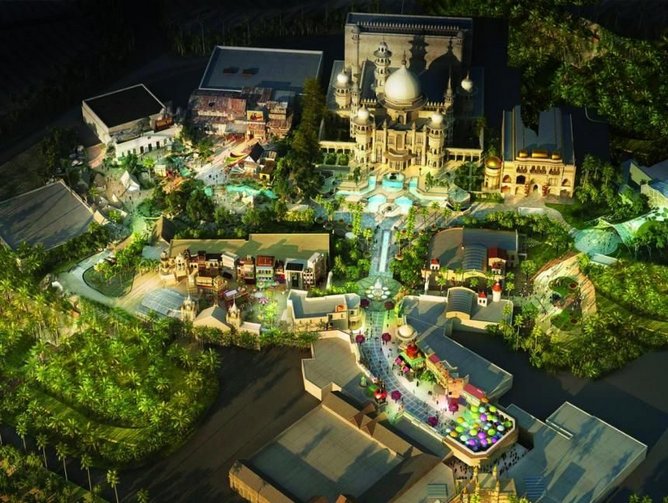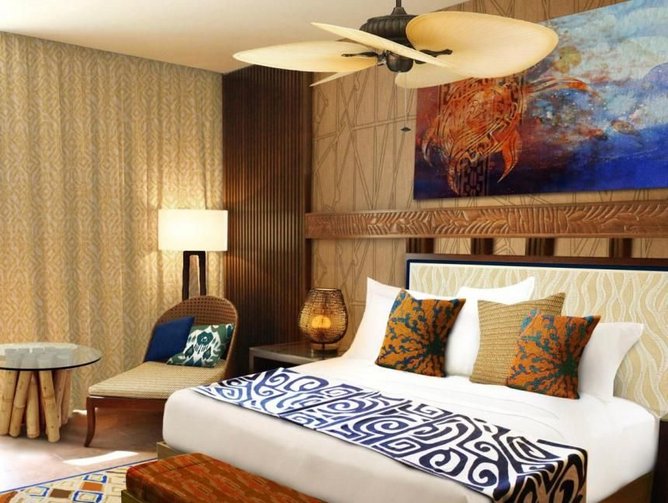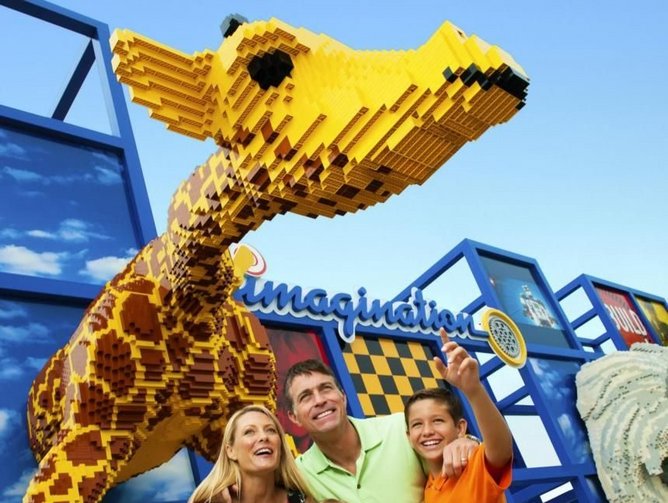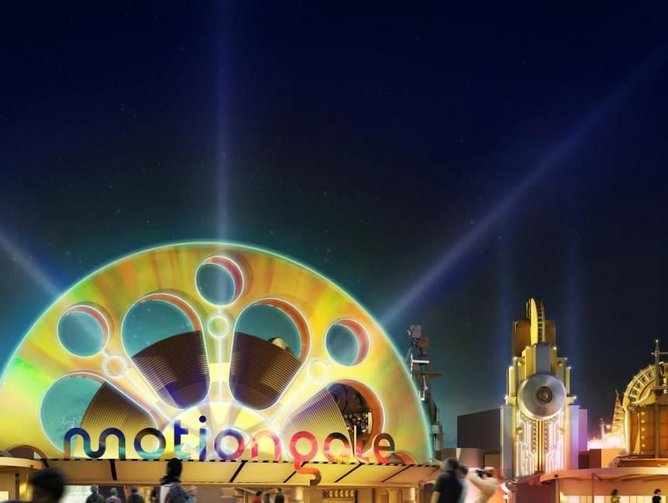When you think of theme parks, you inevitably conjure up images of Mickey Mouse at Disney World or the King Kong ride at Universal Studios in Orlando. And Dubai Parks and Resorts is planning to join that prestigious handful of household names by creating a must-attend entertainment destination in the heart of the UAE. As Chief Technical Officer Matthew Priddy explains: “We have the ability to become a regional leader in the entertainment business. And as we develop the brand of Dubai Parks and Resorts, we can become one of the top three in the world. That’s the goal, we are all very committed to that. And we’ve made a very good start.”
Priddy’s hand-picked team of 30 people boasts at least 500 years of theme park experience between them, each one of them a specialist in his or her field. Despite this degree of knowledge, the industry remains niche, and this allows Priddy and his team to ensure the highest quality at every point of logistical point of the operation.
The Dubai Parks and Resorts project was developed in support of H.H. Sheikh Mohammed bin Rashid Al Maktoums’ vision for the tourism sector. “His Highness’s idea for 2020 involved bringing 20 million visitors,” Priddy explains. “He wanted to diversify the economy and create a family entertainment destination. Design for this project began in January 2013, and ground was broken in March that year. Throughout the remainder of 2013 and the majority or 2014, all the infrastructure was installed and erected, and by 2015 we were integrating the finishes, interiors, and finally the shows and rides themselves.” And having spent a morning touring the Dubai Parks and Resorts site, talking to Priddy, who is responsible for design, engineering and production of shows and rides, it’s easy to see how the goal of becoming one of the top three theme park destination is going to be achieved. This ambitious and exciting destination is due to open in October this year, and the site comprises three theme parks – Legoland® Dubai (and Legoland® Water Park), Bollywood ParksTM Dubai and motiongateTM Dubai, as well as the family oriented, Polynesian-themed LapitaTM Hotel, and a retail, dining and entertainment district called RiverlandTM Dubai. The facts and figures are impressive – the finished site is expecting 6.7 million visits in 2017 and will include over 100 rides and attractions, with 15,860 trees and 6,100 palms on 25 million square feet of land.
The site still looks very much like a construction project – albeit one with a giant meatball (from the movie Cloudy with a Chance of Meatballs) gracing the site – with rides starting to be installed and the buildings that will house many of the attractions going up. Priddy says: “We started a little over three years ago, and back then this site was nothing but desert. In the last two years we have put in the underground utilities, and all primary infrastructure that goes with that, meaning sub stations, water treatment facilities and sewage plants.” With the majority of that background work complete now, the team is focussing on everything from cultivating plants in its nursery for the landscaped areas and moving the first Lego models into position to recruiting over 4,000 staff that will be needed in time for the grand opening. Dubai Parks and Resorts is located on the Sheikh Zayed Road, the main route between Dubai and Abu Dhabi. And it really is the perfect location, says Priddy. “It’s a terrific site because it is equidistant between the two international airports – Abu Dhabi and Dubai. It’s also 10 kilometres from new Al Maktoum airport, which is going to take on the existing traffic from some of the terminals at DXB. It is also close to the Expo 2020 site, so the city is going to grow in this direction. “What ends up happening, from what I’ve seen in my experience at Disney and Universal, is that all the support vendors and suppliers will spring up around the site and become an economic engine, driving growth in this direction.” The career experience that Priddy refers to includes a 20-year career at Disney, including serving as Senior Vice President of Worldwide Production for Walt Disney Imagineering. As Priddy says: “My background really is the theatrical side of the theme park business.” Describing his current team and its role in the strategy of Dubai Parks and Resorts, Priddy says: “My group is an interesting mix of development and operations. We have procurement, contracts, media, R&D, control systems, creative, facilities management, show and ride engineering, technical services.
Our role is diverse, but the important thing for us is to ensure the guest experience. “A theme park and a resort is looking to offer a compelling experience that will make people want to come and it needs to be so compelling that they want to come back and next time they want to bring their friends and their grandparents and they want to stay longer. A longer stay equates to more per capita spending, and that’s the concept of an integrated resort – a theme park on its own, out of town, has a hard job with repeat visitation and length of stay. It doesn’t end up being a destination. Dubai Parks and Resorts is a destination. People will come here and stay for a day, two days, two and a half days.” And Priddy certainly isn’t afraid of any local competition, in fact, he welcomes it. “We are fortunate that we have additional theme parks springing up around the UAE. We don’t look at them as competition, we look at them as another reason to drive the UAE, Dubai and Abu Dhabi as international destinations. We will probably partner with them at some point in the future, when it comes to things like safety standards and creating a theme park organisational mentality in the UAE.” Content is key for the success of any theme park and the team at Dubai Parks and Resorts has carefully selected a rich mix of attractions and experiences that will enable it to quickly become a leader in the region.
Firstly, there is Bollywood ParksTM Dubai, a product that is unique. “Bollywood has never been done as a theme park before and there are millions of Bollywood fans within just a few hours of our site, so we are expecting to have to start the expansion from day one! Bollywood is such a large part of the culture here that making it part of the business plan was a no brainer.” And it is a very vibrant part of the overall Dubai Parks and Resorts offering – the stunning Rajmahal theatre is a striking setting for the 850-seat shows. Priddy adds: “The theatre is very high end in terms of its finishes and its technology for the shows. During the day it will operate as a typical theme park theatre with 20-minute shows. Then at night it turns into a Broadway-style theatre, with an extravagant production based on Kingdom of Dreams, with a cast and crew of 150 people. That’s a separate ticket, which is all part of our strategy to extend the length of stay. A visitor could spend the day at one of the parks, go to RiverlandTM Dubai for lunch, go to the hotel for a rest if they are staying there, then go to Bollywood ParksTM Dubai in the evening for a meal at the high-end themed Indian restaurant, then go to the theatre show.”
The second theme park is motiongateTM Dubai, which Priddy describes as a typical movie park as the attractions are based on films from Hollywood. But, he says, it is atypical as there are many different and diverse IPs at the park. He says: “In the states they would be seen as competitors but they are all together here.” The park will offer attractions based on Sony PictureStudios films (Hotel Transylvania, Ghostbusters and Zombieland, as well as Lionsgate (The Hunger Games). Priddy adds: “Those are not new products but they have never been done in a theme park environment before, so we have been very fortunate. Sony has allowed us to use some of the new ghosts from Ghostbusters. So we are really bringing the films to life in the theme park environment.” Visitors to motiongateTM Dubai will also get to enjoy attractions based on Dreamworks animation films which Priddy says will be housed in one enormous building – big enough to fit in five Airbus 380s. He adds: “Dreamworks has a demographic that runs all the way from little kids to adults, and in my opinion the Dreamworks franchise has the best sense of humour. We will have all sorts of effects that have never been done before – including Kung Fu Panda, How to Train Your Dragon, Shrek and Madagascar.
And all these will be unique in the way the ride technology and animation is being combined and presented to the world.” The park that is aimed at families with younger children is Legoland® Dubai, and the Legoland® Water Park alongside it. Priddy says: “Legoland® Dubai is not unlike the other seven around the world, although we do have one unique feature. Our Miniland a 90-metre diameter dome, which houses architectural icons from the region, created using Lego bricks,– this is clearly weather driven and architecturally it makes a great centrepoint.” The weather in Dubai has definitely been a factor in the design of the attractions, continues Priddy. “We have a fairly elaborate shade programme, to minimise guests being outside. When they’re outside, we try to keep them in the shade. All of our queues are 30 minutes of air-conditioned queue plus 30-45 minutes of cool overflow queue” Talking about the months ahead, Priddy describes the run-up to opening a theme park as a ‘very happy train wreck’. He is referring to all the different teams pushing to get their elements ready, the extensive testing of rides and attractions. “You have to make sure it all works and it’s safe and reliable,” he says. And there is a lot of technology that needs to be tested. “Whether it is control systems, music, development, exterior entertainment lighting, the list just goes on and on and on.
The technologies that we’re combining are programmable ride systems which can vary at speed and has to be put together in conjunction with the soundtrack, with the music, with the media to make sure that we’re hitting all those marks. We’re using lighting, projection, holograms, animated figures, and that is all run by computerised control systems. It’s quite technologically rich.” To make sure all is working as it should when the crowds arrive in October this year, Dubai Parks and Resorts will be initiating what Priddy calls a testing and commissioning. “You might, depending upon the status of things, open one park one day, open another park the next day and so on. This serves two functions.
It allows us to bring out the systems and make sure they’re properly tuned and identify any problems that we might have in parts. It also means we can train the staff. We’re bringing in over 4,000 people, many of whom have limited park operations experience so there is a lot of training and development that has to go on.” Recruiting – and training – this many people is clearly a big challenge but, for Priddy and his team, the procurement phase was equally tricky, because there is only a certain number of people who can produce what a theme park needs, so there may be timing and capacity issues. He says: “Other projects going on in the world were chasing similar resources. So we had to get creative in procuring these packages. And the procurement team did a fabulous job - we managed to find the vendors and structure the packages that we think we’ve got it covered. But it was a challenge.” The hard work was well worth it though, as the park currently has 95 percent of its ride systems either installed or in the warehouse ready to go. “And we’ve got a good 50 percent of all the shows either in the warehouse or on the water which is a tremendous accomplishment by our guys,” Priddy adds. “The goal is to get in and start playing with it so we can make sure we can dig out all problems and deal with them as early as we can. The role of the project manager and the technical division is to look for bad news.
It is to look for problems and deal with them now. Not later. We’re doing a great job.” Without exception, everyone we spoke to at Dubai Parks and Resorts had a love of theme parks running through their bloodstream. A passion that Priddy epitomises. He says: “I majored in theatre technology in UCLA. That is really all about lighting, audio, rigging, scenic construction and stuff like that.” This eventually led to a call from Walt Disney requesting that Priddy join its team building scenery for the Epcot Center. “Typically theme parks at that time used the Hollywood film studios to build all the scenery but it didn’t have the capacity for Epcot so we needed to set up our own. So we built 3.5 million square feet of scenery plus Tokyo Disneyland at the same time and shipped it out of California in 18 months. It was a lot of all nighters but it was a lot of fun.” Earlier on, Priddy mentioned that R&D is part of his responsibility, and it is a fascinating part of a theme park as new and unique attractions are sought. He says: “It’s natural for all of us. You see something and you say ‘Ooooh, I could apply that to some part of the theme park’. Whether it is a technology or a combination of technologies; maybe you have an idea of a special effect and the technology doesn’t exist.
Then you have to come up with it. You have to figure it out with all your smart people what combination of systems technologies and products you can combine and utilise. When we mature as a park and we have the right dialled-in level of talent, I know for a fact that we will become known as one of the top innovators in the business.” While touring the Dubai Parks and Resorts site, our guide was regularly pointing out space that has been allocated for future expansion. And it’s easy to see that will be in the very near future, as it’s impossible to imagine the site being anything other than a huge success. “Once we open and based on market demand we have to think of expansion within the existing parks - each has probably 30 percent of its original size available. We believe our business plan is such that it’s best to have more demand than capacity but at some point that deteriorates the guest experience so we have to be ready to expand.
The rule of thumb is every 18 months, maybe two years, you should be putting in a new attraction that gives you a marketing hit and a spike in attendance.” So, will the site be ready for the crowds in October this year. The answer is a very loud ‘yes’, thanks largely, says Priddy, to strong relationships with suppliers. He says: “I really believe we couldn’t have done this without all of our suppliers, our contractors, our architects and IT consultants. It’s a world class bunch of companies. They have supported us really well. I think in turn we have been a very good client to work with. We pay our bills and we respect their requirements. There was a bit of the stigma from 2008 when the financial crash happened and a lot of people didn’t get paid. So there was a little bit of trepidation on part of some of our partners, but we have done an awesome job dispelling all that to the extent that I believe that every one of our contractors will be back here next time around. Happily.”










